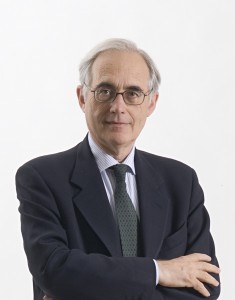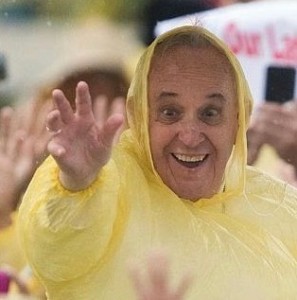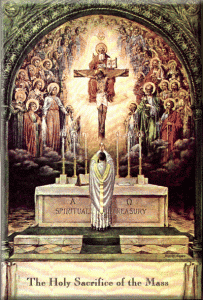
IN THE FIRST four days of 2016, my video Why Do Traditionalists Fear Sedevacantism? managed to rack up a respectable number of views.
It also provoked a testy post by John Salza and Robert Siscoe, authors of True or False Pope? a book urging traditionalists to — wait for it! — fear sedevacantism. They have now dedicated a portion of their website to “sedevacantist watch,” the first watch-ee being me.
Apparently it is acceptable for them to urge Catholics to fear sedevacantism, but a sign of knees-knocking desperation for me to ask why, and then dare to answer the question, which is what I did in the video. This is what they call an “irrational response.”
What you will not be able to “watch” on Messrs. Salza and Siscoe’s post is either a discussion or a refutation, rational or otherwise, of my threefold answer to the question of why traditionalists fear sedevacantism:
- Ancient tribal myths.
- Cowardice and human respect.
- No marketing appeal.
Here I will recapitulate only the first point, because the old tribal myths about the post-Conciliar papacy have begun to crumble in the face of the Francis revolution, and because Messrs. Salza and Siscoe, it seems, have become the new shamans for keeping their tribe entranced and unaware.
Origins of the Myths
To discover the source for the near-irrational fear of sedevacantism that afflicts so many traditionalists, one must first look to the traditionalist movement’s origins in the 1960s and the early 1970s.
Because the Vatican II revolution came “from the pope” and because every good pre-V2 Catholic knew that only non-Catholics “did not recognize the pope” and that only bad Catholics “disobeyed the pope”), proto-traditionalists needed to quickly come up with some sort of plausible explanation for rejecting the errors and evils that Paul VI had officially approved.
The Heart of the Myths
The argument the first traditionalists cobbled together for “resisting the pope” revolved mostly around two primitive notions:
 (1) Catholics are not really bound by what a pope teaches or legislates unless it has an “infallible” stamp on it (for example, when he makes some once-in-a-century proclamation ex cathedra, as Pius XII did for the dogma of the Assumption), and
(1) Catholics are not really bound by what a pope teaches or legislates unless it has an “infallible” stamp on it (for example, when he makes some once-in-a-century proclamation ex cathedra, as Pius XII did for the dogma of the Assumption), and
(2) A pope can be like a “bad dad” whose evil commands you can disobey, but whom you recognize as your dad, no matter what he does.
Both ideas were based on a whole array of theological errors that eventually mutated into what came to be known as the “recognize and resist” (R&R) position towards the Vatican II popes. All these errors have been repeatedly and definitively refuted, based on the standard teaching of pre-Vatican II ecclesiology — that branch of theology that deals with attributes and authority of the Church and the papacy.
But at the time, these primitive notions sounded plausible enough to laymen and priests who didn’t know any better, and they were repeated so often over the years that they became the unquestionable mythology that identified the tribe.
The Propagators
From its foundation in the 1960s, The Remnant was the principal organ in the English-speaking world for spreading and defending this mythology, aided by its chief apologist and shaman, Michael Davies.
In France, it was Itinéraires and eventually, Abp. Marcel Lefebvre’s Society of St. Pius X (SSPX).
Resistance to “Rome” was an easy sell in France simply because a strain of it has run through French history for centuries: Gallicanism, the petite église, the French anti-infallibility faction at Vatican I, and the French political right-wing’s anger in the twentieth century over the papal condemnation of Action Française.
But we Americans don’t exactly have a sterling record either. The traditionalist mythology we are discussing got an early start on our shores in the 1940s with the followers of the excommunicated Jesuit, Father Leonard Feeney, and it has been going strong ever since.
Offspring of the Myths
The original myths that sedevacantism threatened eventually spawned others. Sedevacantism could not be true, we are told, because it would leave us without a pope to consecrate Russia to the Immaculate Heart in conformity with the Fatima message
This argument has long been promoted not only by Messrs. Salza and Siscoe, but also by other R&R Fatima Industry movers and shakers, such as Fr. Nicholas Gruner, Christopher Ferrara and Brian McCall.
Here, a principle invented on the basis of private revelation (which no Catholic is, strictly speaking, obliged to accept) is supposed to trump public revelation (which Catholics are obliged to accept, and which is the data underlying the theological principles for the sedevacantist argument.) The tail wags the dog.
The “Spirituality” of the Myths
Finally, if you have been raised in the R&R camp, you have been taught to fear sedevacantism as “schism.” If you overcome your fear sufficiently to investigate the position, to raise legitimate questions about your tribal myths and to insist on coherent answers based on principles found in the writings of pre-Vatican II theologians and popes, you are told that you are “proud.”
The latter, in particular, is a trick employed by SSPX retreat masters, who are supposed to give at least one conference aimed at indoctrinating retreatants into the SSPX myths. Bad spirituality covers up bad theology.
* * * * *
IT IS perhaps understandable that in the early days of the traditionalist movement, residual pre-Vatican II attitudes toward the papal office, limitations in the means of obtaining news and factual information, and the sheer physical obstacles to conducting theological research led faithful Catholics to settle for simple myths to justify resistance to the man whom faith told them stood in the place of Jesus Christ on earth.
And it is also perhaps understandable that these myths, combined with those promoted by the press about the “conservatism” or “orthodoxy” of John Paul II and Benedict XVI, led many souls to give Wojtyla and Ratzinger, two Thomism-hating modernists underneath, the benefit of the doubt and give in to the fear of sedevacantism.

Dad says OK!
But now we’re talking Bergoglio — who’s moved beyond giving a wink to divorce and remarriage to giving a pat on the back to transsexual “marriage.”
So it is time to put aside the contorted theories of the tribal mythmakers, who claim to “save” the papacy with a theory of “resistance” that destroys it.
You can now see with your own eyes and hear with your own ears, the poisonous modernist heresies of Vatican II, incarnate in the person of Jorge Mario Bergoglio.
As such, he is no mere bad dad with an unused “infallible” stamp in his back pocket — still less, the Vicar of Christ.
He he is the Vicar of the Devil. And no one should be afraid to say it.
Find out how to support our apostolate!







